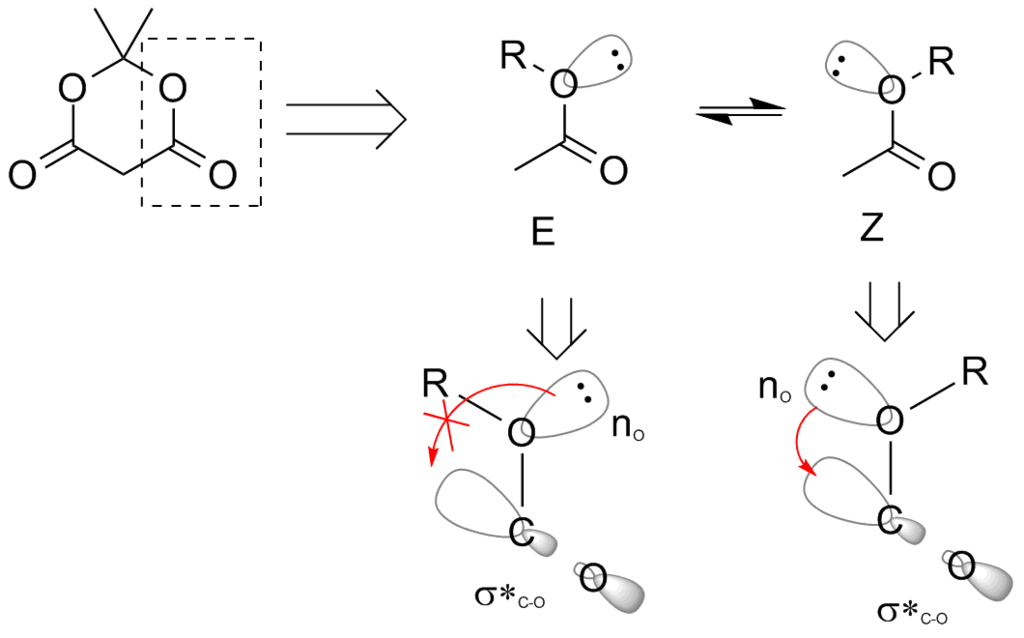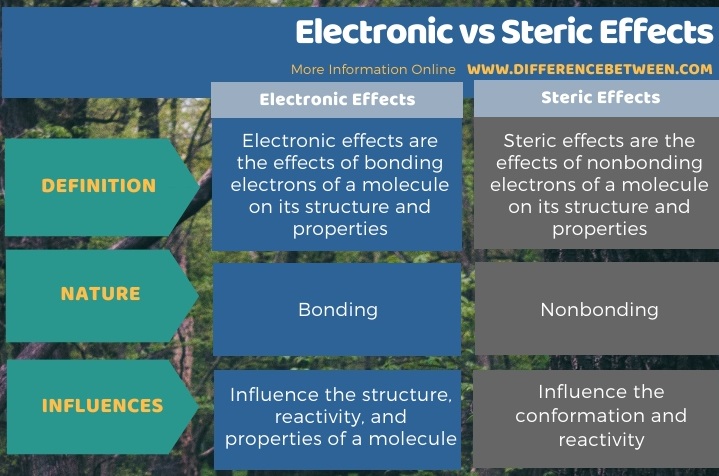The key difference between electronic and steric effects is that electronic effects are bonding interactions whereas steric effects are nonbonding interactions.
Electronic and steric effects are two different chemical concepts that describe the effect of interactions between electrons in a molecule on its structure and properties. The electronic effect describes the effect of the electrons that are in the chemical bonds between atoms of the molecule while steric effect describes the effect of the electrons that are not involved in the chemical bonding but occur as lone electron pairs or nonbonding electrons.
CONTENTS
1. Overview and Key Difference
2. What is an Electronic Effect
3. What is the Steric Effect
4. Side by Side Comparison – Electronic vs Steric Effects in Tabular Form
5. Summary
What is an Electronic Effect?
Electronic effect is the effect of bonding electrons of a molecule on its structure and properties. These effects influence the structure, reactivity, and properties of a molecule but these are not traditional bonds or steric effects.

Figure 01: Stereoelectronic Effect on Esters
There are different types of electronic effects:
- Induction – redistribution of electron density through traditional sigma bonds depending on the electronegativity of the atoms in a molecule
- Conjugation – redistribution of electron density that is transmitted through interconnecting pi bonds
- Hyperconjugation – stabilizing interactions between electrons of a sigma bond and adjacent nonbonding p orbital or antibonding pi orbital
- Electrostatic interactions – attractive and repulsive forces related to the buildup of the electrical charge in the molecule Trans influence – the influence of bonds of coordination complexes on the ligands trans to the bonds (effect of ligands of square planar or octahedral complexes on the ligands)
What is the Steric Effect?
Steric effects are the effects of nonbonding electrons of a molecule on its structure and properties. This effect influences the conformation and the reactivity of ions and molecules. This type of effects happens due to the repulsive forces on the molecule, caused by overlapping the electron clouds.

Figure 2: Different Compound use Different Conformations to Minimize the Steric Hindrance
The major consequence of this effect is a steric hindrance. Steric hindrance refers to the slowdown of the chemical reactions due to the steric bulk of the reactants. Moreover, it alters the shape of the molecule. The knowledge of this chemical concept is very important in the field of chemistry, biochemistry and pharmacology.
What is the Difference Between Electronic and Steric Effects?
Electronic and steric effects are two different chemical concepts that describe the effect of interactions between electrons in a molecule on its structure and properties. The key difference between electronic and steric effects is that electronic effects are bonding interactions, whereas steric effects are nonbonding interactions.
Moreover, another difference between electronic and steric effects is that the electronic effects influence the structure, reactivity, and properties of a molecule, while the steric effect influences the conformation and reactivity.

Summary – Electronic vs Steric Effects
Electronic and steric effects are two different chemical concepts which describe the effect of interactions between electrons in a molecule on its structure and properties. Electronic effect describes the effect of the electrons that are in the chemical bonds between atoms of the molecule while steric effect describes the effect of the electrons that are not involved in the chemical bonding but occur as lone electron pairs or nonbonding electrons. Thus, the key difference between electronic and steric effects is that electronic effects are bonding interactions whereas steric effects are nonbonding interactions.
Reference:
1. “Electronic Effect.” Wikipedia, Wikimedia Foundation, 26 Feb. 2019, Available here.
2. “Basic Principles in Organic Chemistry: Steric and Electronic Effects in a Covalent Bond.” Open Teaching Project, Available here.
3. “Steric Effects.” Wikipedia, Wikimedia Foundation, 14 Nov. 2019, Available here.
Image Courtesy:
1. “ESTER STEREOELECTRONIC EFFECT” By Arnomba – Own work (Public Domain) via Commons Wikimedia
2. “Methyl group cyclohexane” By Emily – Own work (Public Domain) via Commons Wikimedia
ncG1vNJzZmivp6x7pbXFn5yrnZ6YsqOx07CcnqZemLyue8OinZ%2Bdopq7pLGMm5ytr5Wau26xy56araqfo7akecCnm2arpJq%2Fqq%2BMnp2fnZOpwHA%3D